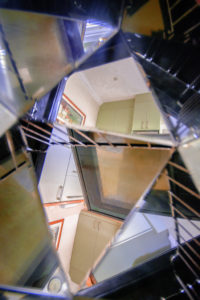On The Inside Looking Out
By Ian Varkevisser | November 11, 2020
There is a story that Italian artist and Picasso contemporary Gino Severini willingly gave his broken (and therefore useless) camera to Picasso, who was curious about the odd images it produced. Picasso played with his new toy and ultimately realized that it showed him a new way to paint. Thus cubism was born.
In the initial months of lockdown the country I live in had extreme restrictions. By and large the population were confined to their houses and not allowed to venture out except to shop for essentials. We were basically on the inside of our dwellings looking out onto a largely empty world.
If Picasso were alive today and confined under similar circumstances what might he have painted and found as sources of inspiration ?
Would it be possible to produce a series of images akin to vibrantly coloured cubist paintings I wondered during these idle times of confinement?
Whilst like Picasso I do not have the luxury of a cracked lens and bearing in mind the cost of gear I was reluctant to take a hammer to one of my lenses. I do have a friend who has a slightly damaged lens but it is a canon mount and that is a story for another day.
So the first hurdle I would need to overcome would be to have that fractured look in the images. To achieve this I rigged up a contraption of 3 mirrors taped together into which a wide angle lens could fit or be jammed with the help of rocket blowers. Then the hunt was on to find places in the home into which I could fit the rig.
What follows is a series of images of a cubist’s impressions of items around the house titled from the inside looking out.
The colour palette has been restricted by changing hues. Overall saturation and vibrance in the images have been pushed in an attempt to simulate gaudy acrylics.
Gear Matters: Fuji X-T10 with canon remote release. The initial 4 images in the series were taken with a 16mm focal length producing limited fracturing. The final 4 images were taken with a 10mm focal length creating more fracturing and abstraction.

Tumble dryer
Note: This articles was originally published on dearsusan.net
Copyright © 2020 Steve Bennett
Ian Varkevisser is an enthusiastic amateur photographer based in Cape Town , South Africa and started photography 8 years ago, approaching his 60th year on this mortal coil.
Being thorough in nature, he signed on to the local photographic society with high hopes of educating himself in the art of photography. He very soon found the parochial attitude and questionable society rules of photography stifling and moved on.
With a formal education in engineering in the high tech industries and being an autodidact, neither the technology of digital equipment, nor the challenge to broaden the scope of his knowledge in composition or photographic technique, proved to be an obstacle. Having lived through the technological revolution since its inception, along with his inquisitiveness, has always lead him to push the boundaries of technology and get the most out of them.
Known for the most part for his street photography, he has had great success recently with his emotive landscape photography. Ian is no stranger to experimental and abstract photography and continues to push the boundaries of both the equipment he has on hand, in addition to what is considered traditional photography.









You are an inspiration!
Please continue pushing the boundaries and showing us mere mortals all that is possible with a camera in hand and a healthy dose of creativity.